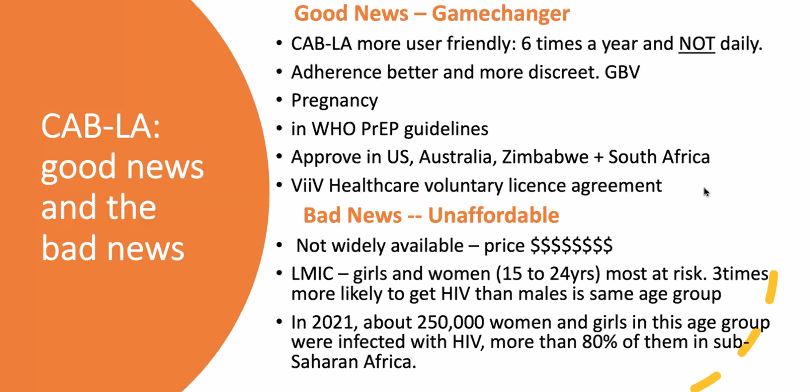By Chemtai Kirui
Long-acting injectable cabotegravir (CAB-LA) is an injectable form of pre-exposure prophylaxis (PrEP). Termed by World Health Organization (WHO) as a safe and highly effective HIV prevention tool, CAB-LA is recommended to be used by people living with HIV as well as for someone seeking to reduce the risk of HIV acquisition.
CAB-LA is said to be a convenient form of ARV’s as it requires the first 2 injections administered 4 weeks apart, followed thereafter by an injection every 8 weeks, as opposed to the Oral PrEP which requires daily intake.
Despite its approval rate, only a few Countries in the world have adopted the new guidelines by WHO for the use of long-acting injectable cabotegravir (CAB-LA) as pre-exposure prophylaxis (PrEP) for HIV. Zimbabwe was the First African country to approve the use of CAB-LA for HIV prevention, followed by South Africa. Internationally, United States and Australia have the approval card as well.
Adele Baleta an award-winning science journalist based in South Africa, who was speaking during a Cross-border Media Science cafés Journalist Dialogue said that “The problem is that CAB-LA is not available at an Affordable price for many in Africa” adding that this is an issue that needs to be reviewed.
In her presentation, Baleta explained that despite availability of years of treatments and prevention tools including CAB-LA, an antiviral injection, HIV is still spreading and we still do not have an HIV vaccine.
“There is a high Increase of New HIV infection rate among girls and Women between the age of 15 and 24 years living in low- and middle-income countries,” Baleta said.

According UNAIDS 2022 global update — a total of 1.5 million people became infected with HIV in 2021 – three times more than the global target of 370 000 new infections a year, out of this number, 250,000 were women and girls (15-24years) and more than 80% of them in sub-Saharan Africa.
This concerning 2021 statistics goes to show that young women of the above-mentioned age bracket are 3 times more likely to get HIV than males in the same age group.
The cases showcase dangerous level of inequalities that according to United Nations report, will slow progress towards ending AIDS, stating how worsening financial constraints, gender inequalities and harmful gender norms, are making it more difficult to address those inequalities.
According to UNAIDS Executive Director Winnie Byanyima, the only effective route map to ending AIDS, achieving the sustainable development goals and ensuring health, rights and shared prosperity, is a feminist route map. She further said that “What world leaders need to do is crystal clear, in one word: Equalize. Equalize access to rights, equalize access to services, equalize access to the best science and medicine. Equalizing will not only help the marginalized. It will help everyone.”

Catherine Mwauyakufa, an award-winning health science journalist from Zimbwabwe, also speaking during the Cross-border Media Science cafés Journalist Dialogue- What is the HIV story now? said that — Not everyone needs to speak openly about their experience with HIV, but for those who can, then they should, because information sharing goes a long way in helping end the issue of Stigmatization. “Spreading awareness about HIV, even in social setting, will enable people living with HIV gain more knowledge that might allow them lead a long and healthy lives”.
Learning more about effective HIV prevention, diagnosis, treatment and care, including available ARV’s drugs, such as CAB- LA, will add another HIV prevention tool. These increasing options will hopefully address health inequities by allow cost cutting —making it widely available.





